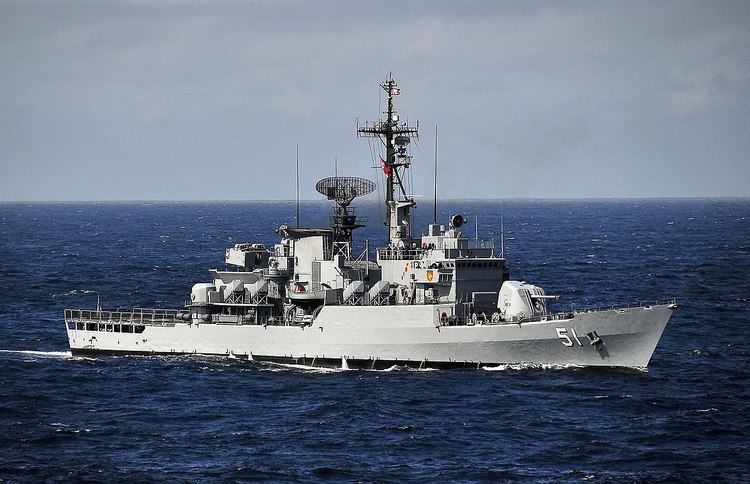Succeeded by Maestrale class | Preceded by Alpino class | |
 | ||
Builders Cantieri Navali Riuniti (CNR)FincantieriSIMA Subclasses Carvajal classMariscal Sucre classArtigliere (Soldati) class | ||
The Lupo class is a class of frigates built by Cantieri Navali Riuniti (CNR) for the Italian Navy. Designed as multipurpose warships with emphasis on anti-surface warfare (ASuW), they have enjoyed some success in the export market, being acquired by the navies of Peru and Venezuela. A small run of a slightly updated version is known as the Soldati class.
Contents
Design
In the early 1970s, the Marina Militare faced an increased Soviet naval presence in the Mediterranean Sea which constituted a threat to its sea lines of communication as well as to its extensive coastline. To parry this menace, Italy started a naval expansion program which included frigates focused on ASuW (Lupo class) and on ASW (Maestrale class).
For the first part of the requirement, CNR presented a design for a 2,500-ton frigate with a high speed and a heavy weapons load. The ship employed a CODOG propulsion plant to achieve 35 knots, making it one of the fastest warships at the time. Armament included 8 SSMs, 8 SAMs, several gun systems, 2 triple torpedo tubes and an ASW helicopter, which was equivalent to that carried by larger warships. Lupo-class frigates have a crew of around 200.
Italian Navy
The Italian Navy commissioned four Lupo-class frigates between 1977 and 1980. These ships were deployed to the Persian Gulf first as escorts for tankers during the last stages of the Iran–Iraq War (1987–1988) and then as part of the Coalition forces during the 1990–1991 Gulf War. After this operations the whole class underwent modernization which included fitting an SPS-702 CORA surface search radar and SATCOM equipment. After two decades in service, the four Italian Lupo-class frigates were decommissioned and sold to Peru in the early 2000s.
In 1996 four new Lupo-class frigates which had been built for Iraq in 1985-87, were incorporated into the Italian Navy as the Artigliere class. These ships feature a telescopic hangar; they were refitted as patrol ships and changes made for Italian service included the removal of all ASW equipment. The four ships are Artigliere ("artilleryman" - pennant F 582), Aviere ("aviator" - F 583), Bersagliere ("sharpshooter" - F 584) and Granatiere ("grenadier" - F 585), and are used in fleet escort or long range patrolling duties.
Soldati-class patrol frigate
Iraq ordered four Lupo-class frigates from CNR in 1980 as part of a naval expansion program just before the Iran–Iraq War. These ships, which feature a telescopic hangar were completed between 1985 and 1987. Due to restrictions on arm sales to Iraq because of the Iran-Iraq War placed by the Italian prime minister Bettino Craxi, the ships remained interned in Italy until the end of that war in 1988. Iraqi President Saddam Hussein then tried to renegotiate the price of these ships (and the other ships purchased from Italy), claiming he should receive a discount due the delay in delivery of the ships. Negotiations and court proceedings were still ongoing when Iraq invaded Kuwait in 1990 and a new arms embargo against Iraq was placed by the United Nations, again blocking the sale. In 1993 all of them were seized and, after being refitted as patrol ships, incorporated to the Marina Militare as the Soldati class in 1996. Changes made for Italian service included the removal of all ASW equipment. The four ships are Artigliere (pennant F 582), Aviere (F 583), Bersagliere (F 584) and Granatiere (F 585), and are used in fleet escort or long range patrolling duties. The Philippines considered acquiring the Soldati class in 2012.
Artigliere has been placed in reserve.
Peruvian Navy
Peru became involved early in the Lupo-class frigate program, ordering four ships in 1973. The Peruvian ships were built to a modified design which included different radars, Aspide instead of Sea Sparrow SAMs and a fixed instead of a telescopic hangar. The first two were built by CNR at its shipyard in Riva Trigoso, Genoa, and commissioned in 1979.
Construction work for the second pair was carried out under license by SIMA (Servicio Industrial de la Marina, Navy Industrial Service) at Callao, with the ships commissioning in 1984 and 1987. Of the Peruvian Lupos, BAP Carvajal (FM-51), BAP Mariátegui (FM-54), BAP Villavisencio (FM-52) and BAP Montero (FM-53) have had their flight decks extended to allow ASH-3D Sea King helicopters to land and refuel, even though they cannot be housed in the ship's hangar.
In November 2004 other ex-Italian Lupo-class vessels were incorporated into the Peruvian Navy: BAP Aguirre (FM-55) (ex-Orsa) and BAP Palacios (FM-56) (ex-Lupo). Finally in August 2006 the last Italian Lupo ships arrived in Callao: BAP Quiñones (FM-58) and BAP Bolognesi (FM-57). In 2013, Carvajal was transferred to the Peruvian Coast Guard and renamed Guardiamarina San Martin.
Venezuelan Navy
Venezuela ordered six Lupo-class frigates from CNR in 1975 as a replacement for older warships. These units were commissioned between 1980 and 1982. In general terms, their appearance and equipment is similar to those built for Peru, except for some small differences in electronics. The first two ships, ARV Mariscal Sucre (F-21) and ARV Almirante Brión (F-22) were upgraded by Ingalls Shipbuilding over a four years period (1998–2002). Modifications of this two ships included:
The other ships in Venezuelan service were expected to undergo an austere version of this upgrade, but finally three ships were out of service.
